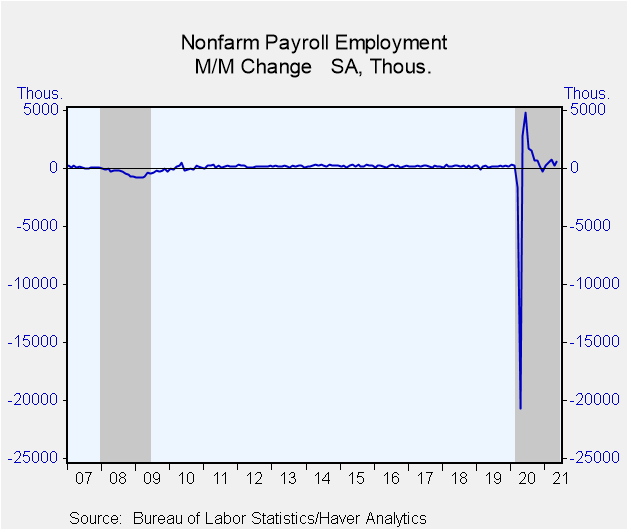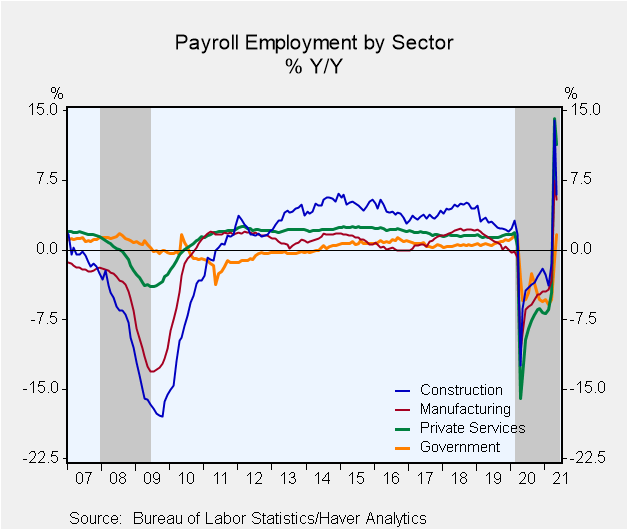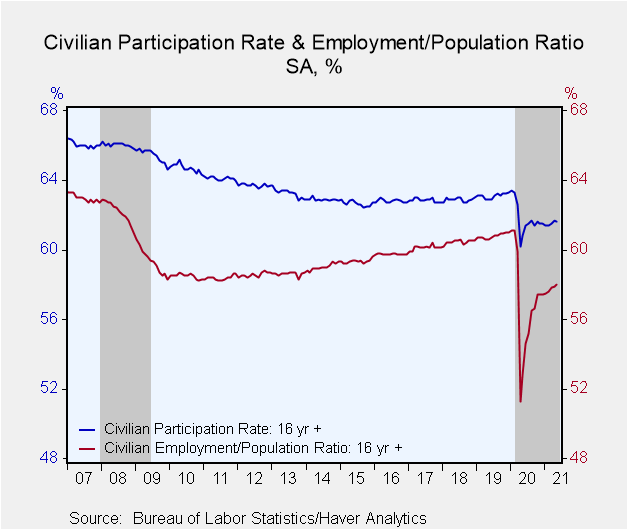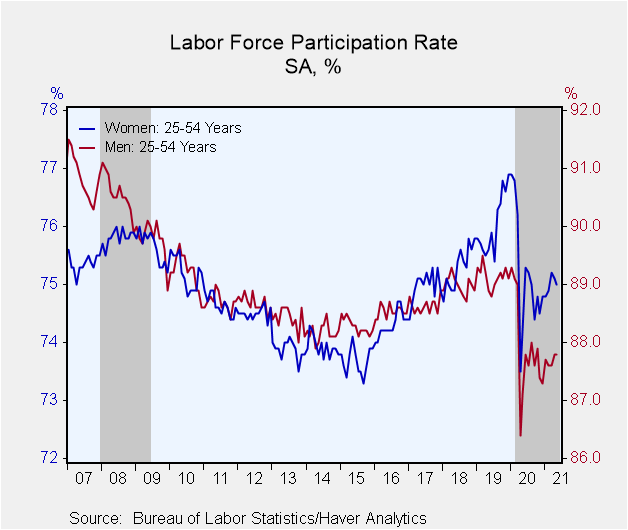 Global| Jun 04 2021
Global| Jun 04 2021U.S. Payroll Gain Disappoints; Earnings Firm as Jobless Rate Declines
by:Tom Moeller
|in:Economy in Brief
Summary
• Factory sector jobs improve but construction jobs fall. • Average hourly earnings are unexpectedly strong. • Unemployment rate moves sharply lower. As more individuals receive the COVID-19 vaccination and restrictions on businesses [...]
• Factory sector jobs improve but construction jobs fall.
• Average hourly earnings are unexpectedly strong.
• Unemployment rate moves sharply lower.
As more individuals receive the COVID-19 vaccination and restrictions on businesses relax, growth in jobs has picked up. Nonfarm payroll employment increased 559,000 (9.0% y/y) during May. A 675,000 rise had been expected in the Action Economics Forecast Survey. This gain was accompanied by an upward revision to the April increase to 278,000 from 266,000. The March increase also was revised higher to 785,000 from 770,000.
Average hourly earnings rose 0.5% last month (2.0% y/y) after an unrevised 0.7% strengthening in April. A 0.2% increase was expected.
The unemployment rate fell sharply to 5.8% in May from 6.1% in April, compared to expectations for a drop to 5.9%. The labor force declined 53,000 after rising 430,000. At the same time, employment in the household survey grew by 444,000 after rising 328,000. The overall unemployment rate, including those who were marginally attached or working part-time for economic reasons, fell to 10.2% from 10.4%. It remained the lowest level since March of last year.
From the payroll employment survey, the 559,000 rise in jobs included a 20,000 fall (+5.9% y/y) in construction employment, following a 5,000 April decline. Also, factory sector jobs gained 23,000 (5.5% y/y) but failed to recover all of April's 32,000 decline. Mining & logging employment held steady (2.2% y/y) following a 1,000 increase.
Private service sector employment rose 489,000 (11.4% y/y), the fifth consecutive month of increase. Leisure & hospitality employment strengthened 292,000 (41.7% y/y) after rising 328,000 in April. Education & health services jobs gained 87,000 (6.4% y/y) following a 25,000 rise. Trade, transportation and utilities employment rose 37,000 (8.8% y/y) after falling 77,000 in April. Retail trade employment fell 5,800 (+11.2% y/y), down for the second straight month. The number of professional & business service jobs rose 35,000 (7.9% y/y) after an 81,000 decline. The number of temporary help service workers improved 4,400 (33.0% y/y) following two months of decline. Information services employment rose 29,000 (5.1% y/y) after rising 9,000, but financial services jobs weakened 1,000 (+2.2% y/y) after two months of modest increase.
Government sector employment rose 67,000 during May (1.6% y/y) following a 59,000 rise. State government payrolls increased 45,000 (-0.2% y/y) after gaining 11,000 in April. Local government employment improved 33,000 (2.6% y/y) after rising 38,000. Federal government payrolls declined 11,000 (0.4% y/y) and fully reversed the April rise.
The 0.5% rise in private sector average hourly earnings last month, and the 0.7% April gain, represented an acceleration in wage growth from the first quarter of this year. Earnings in the leisure & hospitality sector jumped 1.3% (3.7% y/y), about as they did in each of the prior two months. Professional & business services earnings strengthened 1.1% (2.9% y/y) after a 0.6% rise. Trade transportation & utilities pay rose 0.6% (3.3% y/y) after rising 0.9% in May. Financial services pay grew 0.6% (6.7% y/y) after a 0.4% rise while information sector earnings rose 0.3% (1.9% y/y) following a 1.0% jump. Offsetting these gains was a 0.4% decline (+3.1% y/y) in education & health sector earnings which followed a 1.2% strengthening.
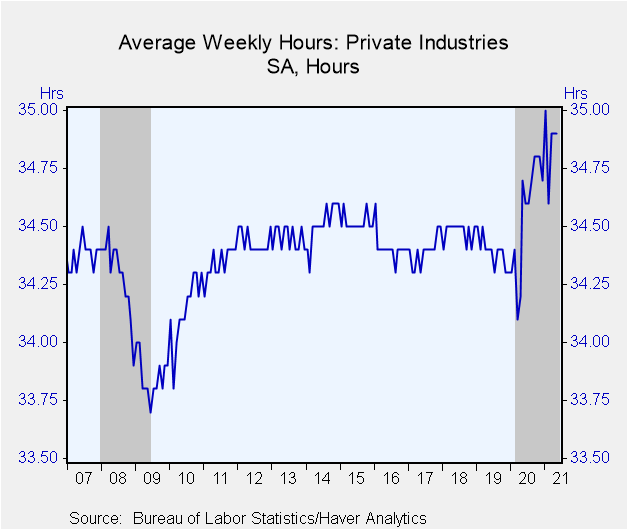 The length of the average workweek held at an elevated 34.9
hours for the third straight month. Mining & logging hours fell to 44.8 from
45.2 and construction hours also fell to 39.0 from 39.1. Factory sector hours
improved to 40.5 from 40.4 averaged earlier this year. Private service sector
hours eased to 33.8 from 33.9 reflecting a slip in professional & business
service hours to 36.7 from 36.8. Financial services hours held steady, however,
at 37.6. Information sector hours improved to 37.5 from 37.3. Education &
health services hours held steady at 33.3 while leisure & hospitality hours
eased to 26.6 from 27.7, still up versus 25.8 hours averaged in Q1 2021.
The length of the average workweek held at an elevated 34.9
hours for the third straight month. Mining & logging hours fell to 44.8 from
45.2 and construction hours also fell to 39.0 from 39.1. Factory sector hours
improved to 40.5 from 40.4 averaged earlier this year. Private service sector
hours eased to 33.8 from 33.9 reflecting a slip in professional & business
service hours to 36.7 from 36.8. Financial services hours held steady, however,
at 37.6. Information sector hours improved to 37.5 from 37.3. Education &
health services hours held steady at 33.3 while leisure & hospitality hours
eased to 26.6 from 27.7, still up versus 25.8 hours averaged in Q1 2021.
From the household employment survey, the lessened 5.8% unemployment rate in May occurred as the labor force participation rate eased to 61.6% and remained below the 63.4% high in January of last year. The teenage participation rate fell to 36.8% from a roughly twelve year high of 37.4% but for individuals aged 20-24, it held at 70.3% for the third straight month. For workers aged 25-54, hours held at 81.3%, but remained below the January 2020 high of 83.0%. For men aged 25-54, the rate was steady at 87.8% but remained down from the high of 89.5% in March of 2019. For women of that age, the rate eased to 75.0%, remaining below the record high of 76.9% in January of last year. For workers aged 55 & over, the participation rate rose slightly to 38.4%, but stood below the July 2019 high of 40.5%.
The employment/population ratio for all workers rose to 58.0% in May, but stayed well below the February 2020 high of 61.1%. A lessened 25.2 million worked at home because of the coronavirus, down by roughly one-half versus May of last year.
The average duration of unemployment remained high at 29.9 weeks, the most since May 2015. The median unemployment duration was 19.3 weeks, the most since June 2012.
The teenage unemployment rate fell sharply 9.6% from 12.3% in April and remained below the record 32.1% in April of last year. The rate for workers aged 20-24 eased to 10.1%. For workers aged 25-54, the rate declined to 5.2%, down from the 12.8% last April's high. For those over 55, the jobless rate rose eased to 4.9%.
By educational attainment, the rate of unemployment of workers without a high school diploma eased to 9.1% from 9.3%, still below the 19.6% rate one year ago. High school graduates without any college were 6.8% unemployed last month, down from last April's high of 17.3%. Those with some college but no degree were unemployed at a slightly higher rate of 5.9%, but still down sharply from the 15.0% last April's peak. College graduates saw their unemployment rate decline to 3.2% last month, but it remained higher than the 1.9% low in February of last year.
The employment & earnings data are collected from surveys taken each month during the week containing the 12th of the month. The labor market data are contained in Haver's USECON database. Detailed figures are in the EMPL and LABOR databases. The expectations figures are in the AS1REPNA database.
| Employment (SA, M/M Change, 000s) | May | Apr | Mar | May Y/Y | 2020 | 2019 | 2018 |
|---|---|---|---|---|---|---|---|
| Payroll Employment | 559 | 278 | 785 | 9.0% | -5.8% | 1.3% | 1.6% |
| Previous Estimate | -- | 266 | 770 | -- | -- | -- | -- |
| Manufacturing | 23 | -32 | 51 | 5.5 | -5.0 | 1.0 | 2.0 |
| Construction | -20 | -5 | 93 | 5.9 | -3.0 | 2.8 | 4.6 |
| Private Service-Producing | 489 | 255 | 565 | 11.4 | -6.6 | 1.4 | 1.5 |
| Government | 67 | 59 | 61 | 1.6 | -3.1 | 0.7 | 0.5 |
| Average Weekly Hours - Private Sector | 34.9 | 34.9 | 34.9 | 34.7 | 34.6 | 34.4 | 34.5 |
| Private Sector Average Hourly Earnings (%) | 0.5 | 0.7 | -0.1 | 2.0 | 4.8 | 3.3 | 3.0 |
| Unemployment Rate (%) | 5.8 | 6.1 | 6.0 | 13.3 | 8.1 | 3.7 | 3.9 |
Tom Moeller
AuthorMore in Author Profile »Prior to joining Haver Analytics in 2000, Mr. Moeller worked as the Economist at Chancellor Capital Management from 1985 to 1999. There, he developed comprehensive economic forecasts and interpreted economic data for equity and fixed income portfolio managers. Also at Chancellor, Mr. Moeller worked as an equity analyst and was responsible for researching and rating companies in the economically sensitive automobile and housing industries for investment in Chancellor’s equity portfolio. Prior to joining Chancellor, Mr. Moeller was an Economist at Citibank from 1979 to 1984. He also analyzed pricing behavior in the metals industry for the Council on Wage and Price Stability in Washington, D.C. In 1999, Mr. Moeller received the award for most accurate forecast from the Forecasters' Club of New York. From 1990 to 1992 he was President of the New York Association for Business Economists. Mr. Moeller earned an M.B.A. in Finance from Fordham University, where he graduated in 1987. He holds a Bachelor of Arts in Economics from George Washington University.


